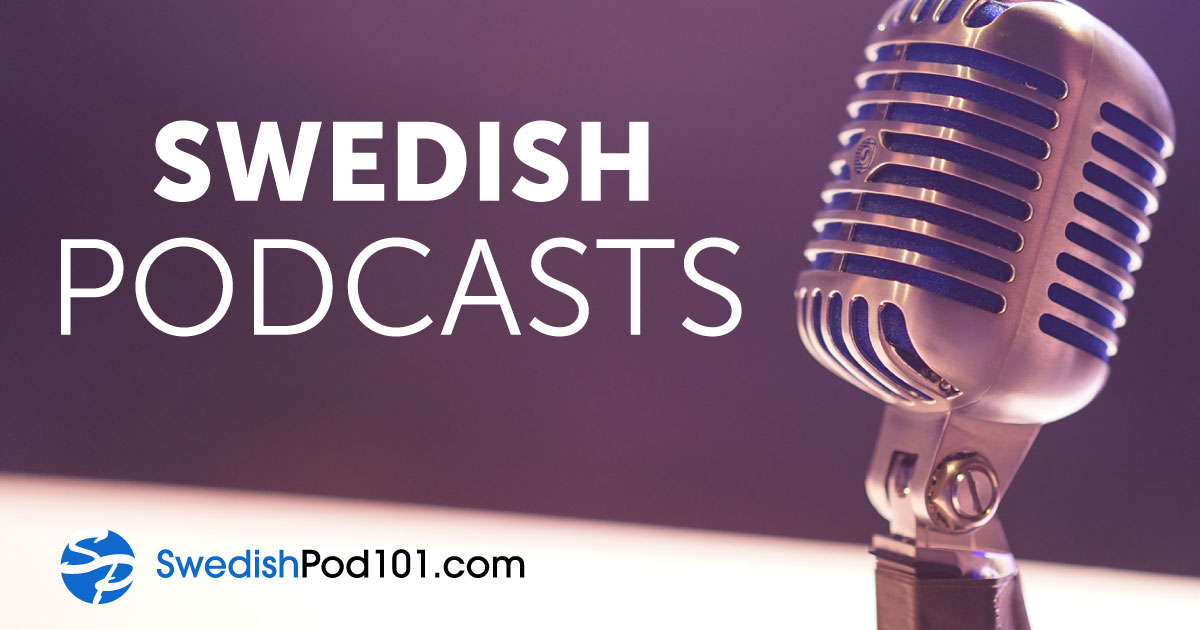
A quick glance at some photos of Swedish cities, and you may realize that Sweden doesn’t look all that different from English-speaking countries. And didn’t the Vikings end up living in the British Isles for a while?
Similarly, Swedish grammar isn’t too far off from English grammar. Whether you look at the vocabulary, word order, or verb conjugation, you’re likely to see some major similarities.
Of course, when you’re learning a language, you’re probably a bit more concerned with the differences. That’s why we’ve created this page: to give you a broad overview of some of the grammatical features of Swedish and how they differ from English. The more you know now, the better-prepared you’ll be in the future!
In this Swedish grammar overview, you’ll learn all the basics you need to get started.
 Table of Contents
Table of Contents
- General Rules
- Swedish Nouns
- Swedish Verbs
- Swedish Adjectives and Adverbs
- Swedish Word Order
- Conclusion
1. General Rules

In general, Swedish grammar is very similar to English grammar, and English speakers won’t have much trouble dissecting the sentences.
But this doesn’t mean that the whole language is easy! Pronunciation and spelling, for instance, have their own challenges—but let’s not get ahead of ourselves.
Native English speakers can learn to read basic Swedish after a couple of weeks or months of regular study, and that’s cut way down if you have any experience at all with German, Dutch, or another Scandinavian language.
So what makes Swedish grammar relatively accessible? Well, to start with, you don’t have any long conjugation patterns to memorize. Swedish verbs don’t change at all for first, second, or third person, and the past and future tenses are formed similarly to how they are in English.
Word order is another area where you’ll be able to easily make connections between Swedish and English. Though there are some sentence structures with “reversed” word order from English, you can count on being able to express your thoughts in the same order as you would in English.
You’ll run into some rough spots with grammatical gender, though. Swedish has two word genders and it’s not always clear which one to use with which word. They just have to be memorized separately, and this extends to which form of adjectives you’ll need to use.
In fact, let’s explore Swedish nouns a bit more right now.
2. Swedish Nouns

In Swedish grammar, gender dictates which article is used with a noun as well as the form of any adjectives describing that noun. Unlike Old English or German, Swedish has not three but two word genders for nouns: common and neuter.
For example, the words katt (“cat”), tomat (“tomato”), and flicka (“girl”) are all common gender, while lokomotiv (“locomotive”), hus (“house”), and piano (“piano”) are all neuter gender. Common nouns take the indefinite article en while neuter nouns take ett. Therefore, you’ll often see nouns simply described as en-words and ett-words in Swedish grammar lessons.
If you’ve never learned a language with grammatical gender before, you may be wondering what exactly makes a locomotive more neutral or less common than a tomato. Well, you’re better off not looking for logic in the system, as it really developed on the basis of words sounding naturally easier to say with one article over the other. Over time, these sounds shifted and new words were adopted, and at this point it’s just something that has to be memorized.
As you learn Swedish vocabulary, you should try and memorize each noun with its gender so that you always know the correct article to use. At the beginning, it’ll be confusing, but as you learn more and more words, your brain will get used to adding that extra little detail in its mental dictionary.
Another typical Scandinavian grammatical feature present in Swedish is how the definite article attaches to nouns. Unlike in most European languages, the definite article in Swedish is directly attached to the noun.
This suffix generally takes the form of the suffix –en or –et (sometimes shortened to –n or –t). For example: ett piano (“a piano”) becomes pianot (“the piano”).
- → Do you want to get a head start? Then check out our vocabulary list of the Most Common Nouns!
3. Swedish Verbs

A huge chunk of understanding Swedish grammar is getting a grasp of how verbs work.
On the whole, you can think of Swedish verbs as being just about as difficult as English verbs. However, Swedish is a little bit more regular when it comes to identifying which words are verbs in the first place.
In the present tense, Swedish verbs always end in the suffix -r.
- Jag ringer dig ikväll. / “I’ll call you tonight.”
From this example, you can see that Swedish expresses “I’ll call” with the present tense (Jag ringer), instead of English’s compound future. This is because the present tense in Swedish can indicate future events if the time is specified, in this case ikväll (“tonight”). It also covers English’s present progressive (“I am calling”) and present habitual (“I call”).
The other verb forms in Swedish are:
- The Imperative
- “Call!”
- telling someone to do something
- The Preterite
- “I called.”
- the simple past tense
- The Perfect
- “I have called.”
- compound past
- The Infinitive
- “I plan to call.”
- used with modal verbs
Here are a couple more examples:
- Hon tänker ringa till Lina. / “She plans to call Lina.”
- Ringde Lars? / “Did Lars call?”
This terminology may be new to you, but remember that it’s quite similar to the set of tenses that English has. The only difference is that the present perfect (“had done”) is used more commonly in speech than the preterite is.
Swedish also has quite a few irregular verbs, just like English and other Germanic languages. In these cases, the verb stem itself will often change.
As in most languages, the verbs you see the most tend to be the ones that are irregular. This is a blessing and a curse. On the one hand, you have to learn so many irregular verbs to communicate on a basic level. On the other hand, though, these verbs crop up so frequently that they’re naturally absorbed into your mind without you having to spend extra time reviewing them!
- → See our vocabulary list of the 50 Most Common Verbs to get a head start in your vocabulary learning!
4. Swedish Adjectives and Adverbs

In Swedish, adjectives have different forms related to word gender, just like nouns do.
When we put an adjective after a word (called a predicate adjective), we always use the base form with no endings.
- William är snäll. / “William is kind.”
How about when you place the adjective in front of the noun? That’s where the complexity arises.
For en-words, we use the base form of the adjective. If “nice” is fin and “flower” is blomma:
- Det här är en fin blomma. / “This is a nice flower.”
Ett-words add a -t.
- Det här är ett fint piano. / “This is a nice piano.”
These basic Swedish grammar rules will take you far, though there are other rules to follow based on the final sound in the adjective. If you first encounter an adjective in the ett-form, you may not be able to perfectly guess the en-form in every case.
If you feel that the gender aspect of Swedish nouns is challenging, then you’re also likely to find Swedish adjectives challenging. The best advice is to learn words in context.
Adverbs, on the other hand, shouldn’t pose a lot of trouble. They’re formed quite regularly, almost always ending in -t.
- Jag hoppar högt. / “I jump high.”
Don’t forget to view our vocabulary list of the Most Common Adjectives to learn some useful words in context!
5. Swedish Word Order

Swedish can be described as a verb-second language, where the verb always takes the second place in the sentence. In English, the verb tends to simply follow the subject except in especially formal writing.
- Nu går jag hem. / “Now I am going home.”
Note the use of the simple present tense to refer to an ongoing action in this example!
Apart from the verb-second rule, in normal main clauses the word order tends to be subject-verb-object, just like in English.
- Jag köpte en banan i affären. / “I bought a banana in the store.”
Pay attention to where you place adverbs of time in a sentence. In English, they go between the subject and verb, but Swedish is very strict about that verb-second rule.
- Jag köper alltid bananer. / “I always buy bananas.”
Another slight difference from English is the treatment of yes/no questions. In Swedish, these always begin with the verb, but there’s no helping word (do) as in English. It’s exactly like reversing the word order.
- Kommer du från Sverige? / “Do you come from Sweden?”
The direct translation, “Come you from Sweden?” sounds archaic to modern English ears, but the best part is that it still sounds like good English. This means that this aspect of Swedish grammar is super-easy to pick up.
6. Conclusion
Do you still have some questions about Swedish grammar? Of course you do!
Since Swedish is so close to English, you can pick up a lot of the nuances automatically by doing a lot of reading and listening to authentic Swedish material, like the stuff on SwedishPod101.com.
And our resources don’t stop there. In addition to explainer videos and special podcast episodes, SwedishPod101 has a whole series of articles letting you know exactly what to pay attention to as you move onto more advanced grammar topics.
The best way to learn a language is to balance direct study of the language’s complicated features with regular consumption of high-quality content. SwedishPod101 is simply the best place for both.













